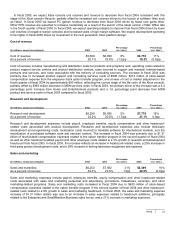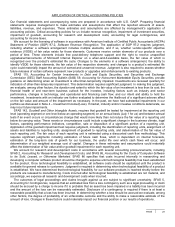Microsoft 2004 Annual Report Download - page 27
Download and view the complete annual report
Please find page 27 of the 2004 Microsoft annual report below. You can navigate through the pages in the report by either clicking on the pages listed below, or by using the keyword search tool below to find specific information within the annual report.
PAGE 27
front net payment of $264 million. Cash used for investing was $10.85 billion in fiscal 2002, an increase of $2.11 billion
from fiscal 2001.
We have no material long-term debt. Stockholders’ equity at June 30, 2004 was $74.8 billion. We will continue to invest
in sales, marketing, product support infrastructure, and existing and advanced areas of technology. Additions to property
and equipment will continue, including new facilities and computer systems for research and development, sales and
marketing, support, and administrative staff. Commitments for constructing new buildings were $129 million on June 30,
2004. We have operating leases for most U.S. and international sales and support offices and certain equipment under
which we incurred rental expense totaling $318 million, $290 million, and $331 million in fiscal 2002, 2003, and 2004,
respectively. We have issued residual value guarantees in connection with various operating leases. These guarantees
provide that if we do not purchase the leased property from the lessor at the end of the lease term, then we are liable to
the lessor for an amount equal to the shortage (if any) between the proceeds from the sale of the property and an agreed
value. As of June 30, 2004, the maximum amount of the residual value guarantees was approximately $271 million. We
believe that proceeds from the sale of properties under operating leases would exceed the payment obligation and
therefore no liability currently exists. We have not engaged in any related party transactions or arrangements with
unconsolidated entities or other persons that are reasonably likely to materially affect liquidity or the availability of
requirements for capital resources.
On July 20, 2004, our board of directors approved a quarterly dividend of $0.08 per share payable on September 14,
2004, to shareholders of record on August 25, 2004. In addition, the board approved a plan to buy back up to $30 billion in
Microsoft Common stock over the next four years. The specific timing and amount of repurchases will vary based on
market conditions, securities law limitations, and other factors. The repurchases will be made using our cash resources.
The repurchase program may be suspended or discontinued at any time without prior notice. The board also approved a
one-time special dividend of $3.00 per share, or approximately $32 billion, subject to shareholder approval of stock plan
amendments that will allow certain adjustments to employee equity compensation awards to offset the impact of the
special dividend. The special dividend will be payable on December 2, 2004, to shareholders of record on November 17,
2004, conditioned upon shareholder approval of amendments to the employee stock plans at the annual meeting of
shareholders scheduled to be held November 9, 2004.
We believe existing cash and short-term investments, together with funds generated from operations should be
sufficient to meet operating requirements and our special dividend as well as regular quarterly dividends. Our philosophy
regarding the maintenance of a balance sheet with a large component of cash and short-term investments, as well as
equity and other investments, reflects our views on potential future capital requirements relating to research and
development, creation and expansion of sales distribution channels, investments and acquisitions, share dilution
management, legal risks, and challenges to our business model. We continuously assess our investment management
approach in view of our current and potential future needs.
Off-balance sheet arrangements and contractual obligations
Off-balance sheet arrangements
We have unconditionally guaranteed the repayment of certain Japanese yen denominated bank loans and related interest
and fees of Jupiter Telecommunication, Ltd., a Japanese cable company (Jupiter). These guarantees arose on February
1, 2003 in conjunction with the expiration of prior financing arrangements, including previous guarantees by us. The
financing arrangements were entered into by Jupiter as part of financing its operations. As part of Jupiter’s new financing
agreement, we agreed to guarantee repayment by Jupiter of the loans of approximately $51 million. The estimated fair
value and the carrying value of the guarantees was $11 million and did not result in a charge to operations. The
guarantees are in effect until the earlier of either repayment of the loans, including accrued interest and fees, or February
1, 2009. The maximum amount of the guarantees is limited to the sum of the total due and unpaid principal amounts,
accrued and unpaid interest, and any other related expenses. Additionally, the maximum amount of the guarantees,
denominated in Japanese yen, will vary based on fluctuations in foreign exchange rates. If we were required to make
payments under the guarantees, we might recover all or a portion of those payments upon liquidation of Jupiter’s assets.
The proceeds from an asset liquidation cannot be accurately estimated due to the many factors that would affect the
valuation and realization of the proceeds.
We provide indemnifications of varying scope and amount to certain customers against claims of intellectual property
infringement made by third parties arising from the use of our products. We evaluate estimated losses for such
indemnifications under SFAS 5, Accounting for Contingencies, as interpreted by FIN 45. We consider factors such as the
degree of probability of an unfavorable outcome and the ability to make a reasonable estimate of the amount of loss. To
date, we have not encountered material costs as a result of such obligations and have not accrued any liabilities related to
such indemnifications in our financial statements.
























